A new predator of rabbits has been introduced within an ecosystem.
This new predator runs faster than the native predators of
rabbits.
Which statement describes what will most likely occur in
the rabbit population due to the introduction of the predator?
A
The rabbits will mutate their genes and express genes that increase
their speed.
B Slower rabbits will develop stronger legs and pass
this trait to their offspring.
C Rabbits will mate and produce
offspring with a different species that has faster runners.
D
Faster rabbits will survive and reproduce increasing the average speed
of the rabbit population.
D
Which answer choice best describes a community?
F Praying
mantises caring for their young
G Three-spined sticklebacks
living in estuaries
H Different species of lizards occupying the
same niche in a desert
J Roosting mother bats recognizing their offspring
H
Eight components present in nucleic acids are listed in the
box.
Components of Nucleic Acids
1. Phosphate
2. Ribose
sugar
3. Deoxyribose sugar
4. Uracil
5. Thymine
6.
Adenine
7. Guanine
8. Cytosine
Which components bond
with adenine in a section of double-stranded DNA?
A 1, 3, 5, and
6 only
B 3 and 5 only
C 2 and 4 only
D 3, 4, 7, and 8 only
B
What would be the most likely effect of a wildfire that burned a
large area of a forest?
F More sugars and starches would be
available for animals in the area.
G The availability of fossil
fuels for use by industries in the area would be reduced.
H Less
carbon dioxide would be removed from the atmosphere in the area by
plants.
J An increase in animal respiration would increase the
release of carbon dioxide in the area.
H
Which four body systems interact to allow a person to sneeze?
A
Muscular, immune, nervous, respiratory
B Nervous, respiratory,
circulatory, skeletal
C Respiratory, endocrine, skeletal,
circulatory
D Lymphatic, skeletal, respiratory, muscular
A
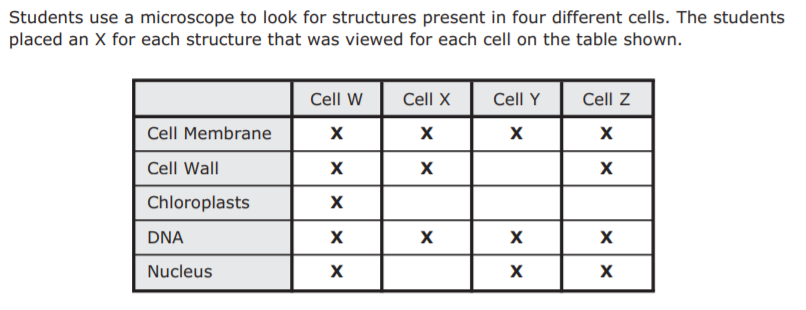
Which cell that was viewed is most likely a prokaryote?
F Cell
W
G Cell X
H Cell Y
J Cell Z
G
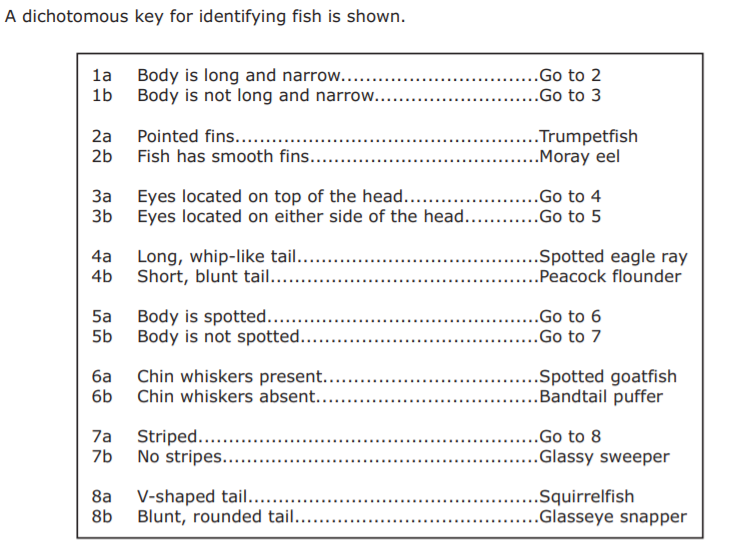
Based on this key, which two fish have eyes located on either side of
their head and are not spotted?
A Glassy sweeper and
squirrelfish
B Glasseye snapper and spotted eagle ray
C
Spotted goatfish and bandtail puffer
D Peacock flounder and
glassy sweeper
A
Students are modeling mRNA during the process of protein synthesis.
Which answer choice correctly describes the model of the mRNA strand
being transcribed?
F The mRNA strand is complementary to the DNA
template strand; however, uracil instead of adenine is paired with
thymine.
G The mRNA strand is complementary to the DNA template
strand; however, uracil instead of thymine is paired with
adenine.
H The mRNA strand is an exact copy of the DNA template
strand; however, uracil instead of adenine is paired with
thymine.
J The mRNA strand is an exact copy of the DNA template
strand; however, uracil instead of thymine is paired with adenine.
G
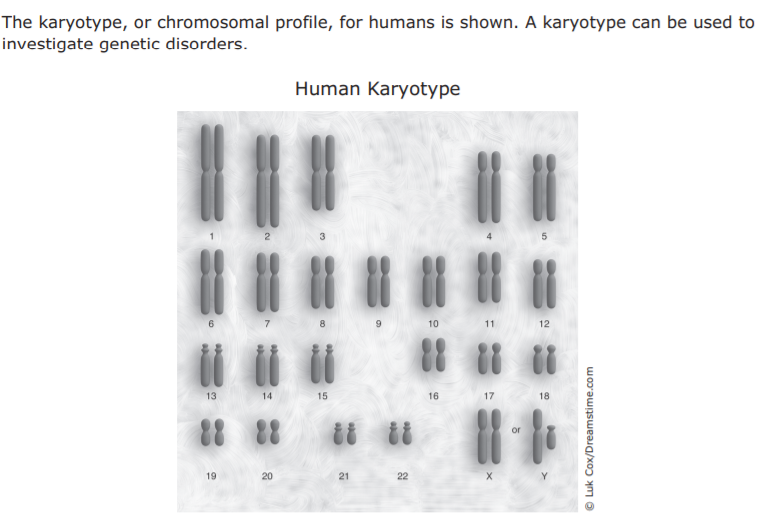
The chemical colchicine is used in the production of karyotypes. Colchicine prevents spindle fibers from forming during the cell cycle.
What is a result of preventing spindle fibers from forming?
A
The cell cycle skips G phase and repeats G phase. 0 1
B Mitotic
division is skipped, and the cell cycle proceeds to
cytokinesis.
C Mitotic division stops in metaphase and cannot
proceed to anaphase.
D The cell cycle skips S phase and proceeds
to G phase
C
A team of students encounters an unknown organism in a field while
conducting a biodiversity study. Some students think the organism is a
plant, while others think it is a fungus. Which question should the
students investigate to classify the organism correctly?
F Is
there a cell wall around the cells of the organism?
G Does the
organism perform photosynthesis?
H Is there nervous tissue
present in the organism?
J Does the organism reproduce sexually?
G
The San Marcos salamander, Eurycea nana, is a light reddish-brown
translucent salamander about 2–5 cm in length. E. nana is found only
in Spring Lake and a portion of the San Marcos River.
Which human
activity would most likely decrease the ability of the salamanders to
survive?
A Increasing water consumption that decreases the flow
of clean water from the springs that feed the river
B Public
transportation that reduces the number of automobiles that contribute
to pollution runoff into the river
C Tourism that helps fund the
educational programs related to river ecosystem conservation
D
The addition of a new food source into the river that limits
competition for resources
A
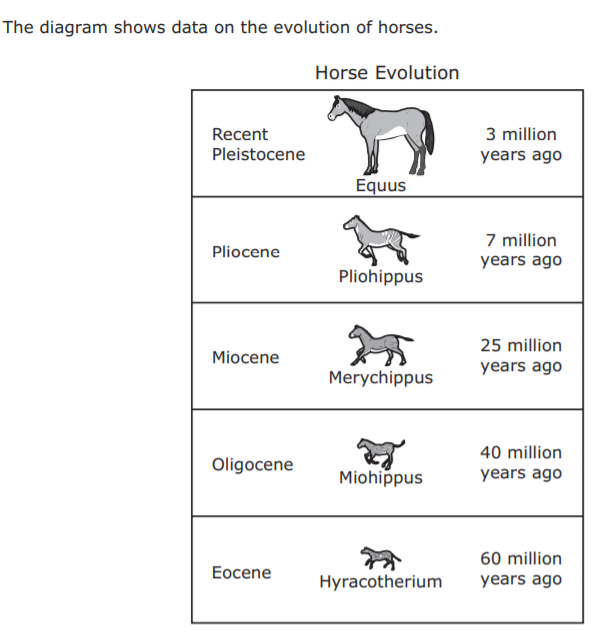
The data in the diagram is evidence that —
F a new species of
horse suddenly appeared
G horses slowly developed over
time
H horses have similar stages of rapid embryological
development
J horses have a common ancestry with other hooved animals
G
Which of these describes the similar functions of capsids and nuclear
membranes?
A Both transport proteins throughout the
structures.
B Both provide energy for activities in the
structures.
C Both protect genetic information for the
structures.
D Both code for the proteins needed for reproduction
of the structures.
C
Enzymes are proteins that have a three-dimensional shape that is
specific to a particular substrate. Environmental conditions can
change the shape of the protein.
What is the most likely result
if the shape of the enzyme changes?
F The substrate will change
its shape to match the enzyme.
G The enzyme will no longer be
able to catalyze the reaction with the substrate.
H The products
made from the enzyme and the substrate will be changed.
J The
enzyme will be able to bind to more diverse substrates than before.
G
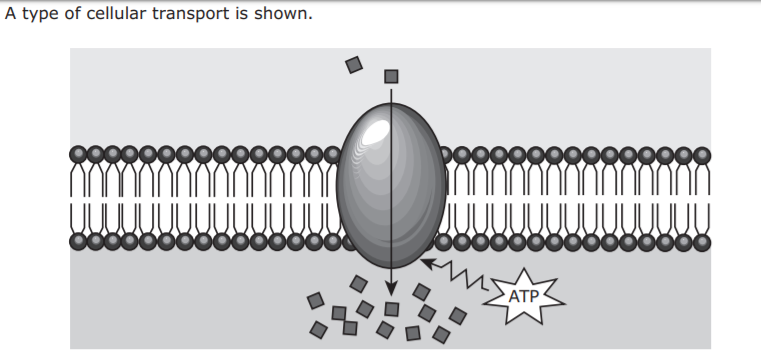
Which description best identifies this type of cellular
transport?
A Active transport, because energy is being used to
move molecules against the concentration gradient
B Facilitated
diffusion, because energy is being used to move molecules with
the
concentration gradient
C Osmosis, because energy is not
being used to move molecules with the concentration gradient
D
Endocytosis, because energy is not being used to move molecules
against the
concentration gradient
A
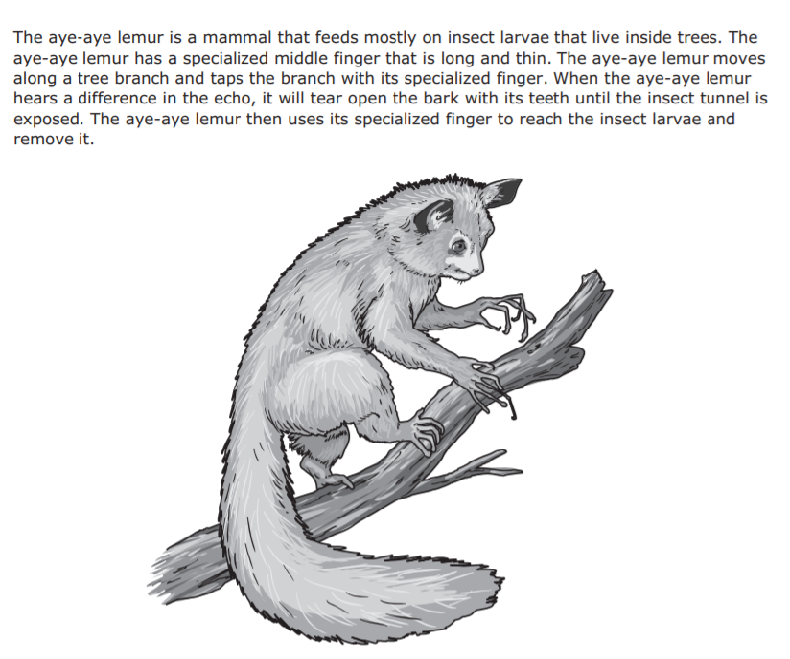
Which selective pressure most likely resulted in the development of
the aye-aye lemur’s special adaptation?
F Limited availability of
water
G Competing for mates
H Large numbers of natural
predators
J Food sources that are hard to find
J
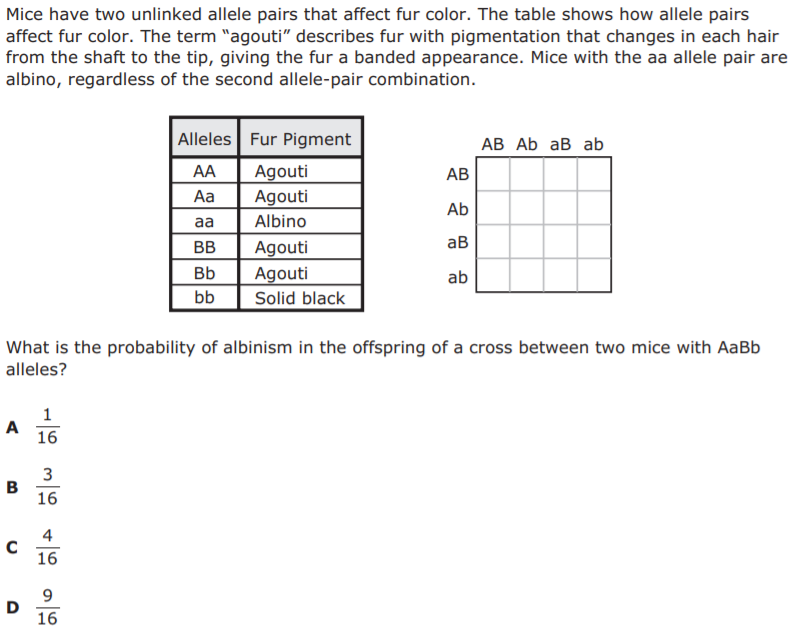
C
Gibberellins are hormones produced in the root tips of plants. The
plant uses these hormones to stimulate the growth of shoots.
How
are gibberellins able to affect other parts of the plant?
F
Gibberellins are absorbed through the stomata and attach to
chloroplasts.
G Gibberellins are transported through vascular
tissues to other parts of the plant.
H Gibberellins become
concentrated within the tissues of the plant during mitosis.
J
Gibberellins become modified once they infect healthy cells and are
later released to infect other cells.
G
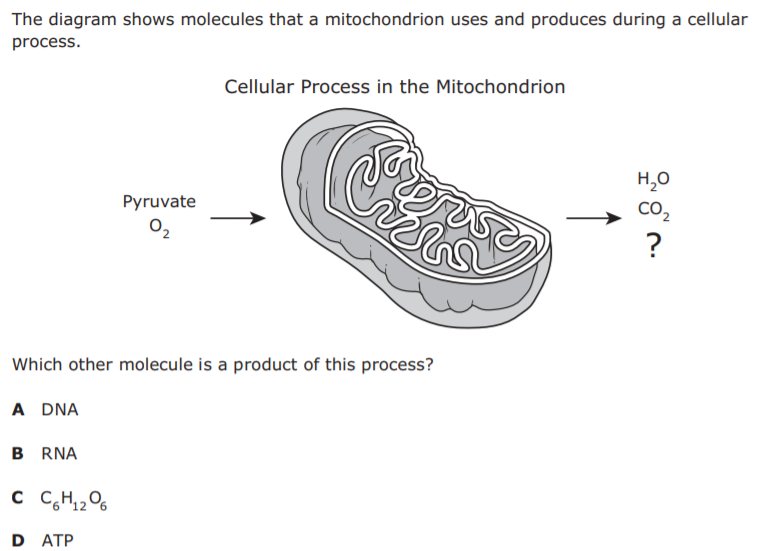
D
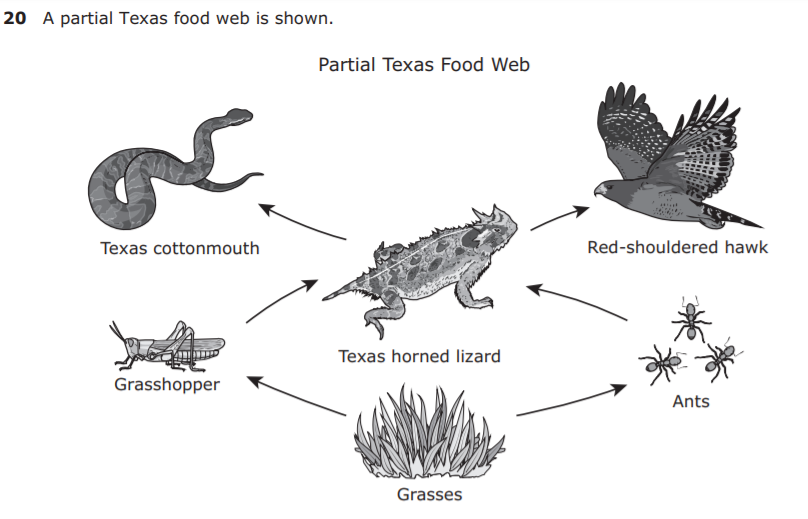
The populations of which organisms will most likely increase as a
result of a disease that suddenly reduced the population of Texas
horned lizards?
F Grasses and ants
G Ants and
grasshoppers
H Grasshoppers and Texas cottonmouths
J Texas
cottonmouths and red-shouldered hawks
G

Which statement provides the best explanation for the difference in
biomass of organisms found at each trophic level?
A Organisms at
higher trophic levels have less energy available to them than
organisms at lower trophic levels.
B Organisms at higher trophic
levels require smaller habitats than organisms at lower trophic
levels.
C Organisms at lower trophic levels provide less energy
than organisms at higher trophic levels.
D Organisms at lower
trophic levels outcompete organisms at higher trophic levels.
A
Conservation biologists studying cheetah populations have determined
that the lack of genetic diversity among the cheetahs is due to
genetic drift.
Which statement explains the most likely
consequence of having a low genetic diversity on the cheetah
population?
F The chances of a mutation occurring in the cheetah
population are decreased, increasing the cheetah survival rate.
G
The gene pool remains in equilibrium and future generations of cheetah
offspring are stronger and better adapted to their
environments.
H The cheetah population becomes less likely to
survive an outbreak of a disease or an environmental change,
increasing the chance of species extinction.
J Genetic
variability is maintained from older cheetah populations that have
survived and endured environmental stressors.
H
CRISPR-Cas9 is a genetic modification technique that edits parts of
the genome of an organism. Using this technique scientists can add,
remove, or modify sections of the DNA sequence.
How can
scientists use this technique to control gene expression?
A By
activating or deactivating specific genes
B By calculating the
number of genes different organisms produce
C By identifying how
closely related one individual is to another
D By determining the
number of chromosomes in an organism
A
During secondary succession, which of these best describes why
decomposing pioneer plants give way to larger, more complex plants
species, such as hardwood trees?
F Increased amounts of sunlight
are able to reach the ground while the pioneer species are
decomposing.
G Increased soil temperatures from decomposing
pioneer species help tree seeds germinate more quickly.
H
Increased amounts of decomposing pioneer species remove nutrients that
tree seedlings need to grow and mature.
J Increased amounts of
soil from decomposing pioneer species allow plants with more extensive
root systems to become established.
J
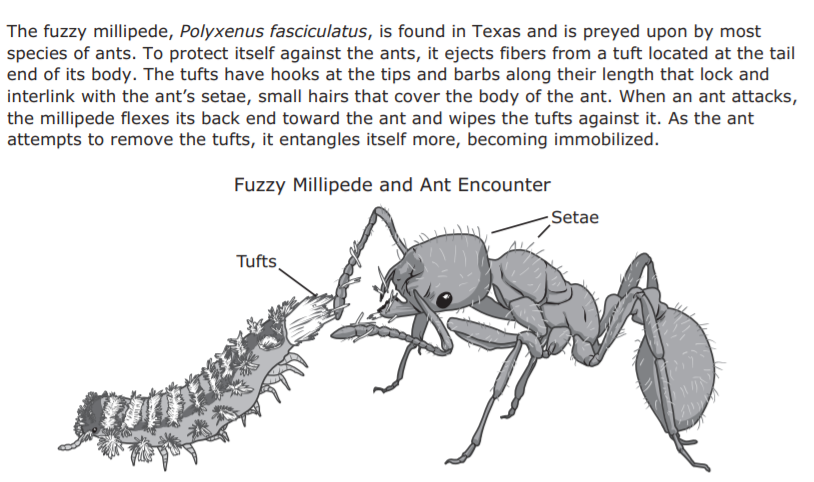
Which two systems most directly interact in the fuzzy millipede’s
defense against ants?
A Muscular and integumentary
B Immune
and muscular
C Integumentary and endocrine
D Endocrine and immune
A
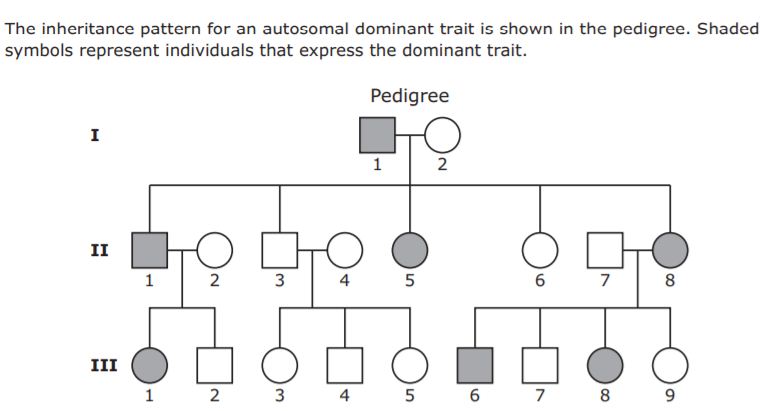
Based on this pedigree, what are the most likely genotypes of
individuals I-1 and I-2?
F: (I-1: aa, I-2: Aa)
G :(I-1: AA, I-2: Aa)
H:( I-1: Aa, I-2: aa)
J: (I-1: aa,
I-2: AA)
H
When cells lose their ability to regulate the cell cycle, they can
divide at an accelerated rate and form a mass of cells. This mass of
cells is referred to as —
A a tumor
B an embryo
C a
gland
D an organ
A

Which type of mutation does the model demonstrate?
F
Deletion
G Insertion
H Substitution
J Translocation
G
Many tree frog populations are threatened due to habitat loss. In an
effort to promote conservation, tree frogs may be bred in captivity. A
zoo acquired male and female tree frogs from two different
populations. In the zoo, the tree frogs were able to successfully mate
within their own population, but breeding attempts between the two
populations were unsuccessful.
Based on this information, which
statement correctly describes the relationship between the two
populations of tree frogs?
A They are in the same species but
different kingdoms.
B They are in the same class but different
phyla.
C They are in the same family but different orders.
D
They are in the same genus but different species.
D
In a study of physical endurance, researchers observed significant
increases in the heart rates and breathing rates of participants
immediately after they engaged in strenuous exercise.
Which
statement best explains the increase in the heart rate and the
breathing rate during exercise?
F The water concentration in the
blood increases.
G Body cells require increased oxygen as energy
is expended.
H Muscle cells increase in temperature and require
fluid to reduce the temperature.
J An increase in muscle activity
causes increases in glucose levels in red blood cells.
G
In 1898 Friedrich Loeffler and Paul Frosch found evidence that the
cause of the highly contagious hoof-and-mouth disease in livestock was
a microscopic infectious particle. It was discovered that this
particle requires a host cell to reproduce.
Which pathogen is
most likely responsible for causing hoof-and-mouth disease in
livestock?
A A bacterium, because it is contagious
B A
fungus, because it infects livestock
C A protist, because it is
microscopic
D A virus, because it requires a host cell to reproduce
D
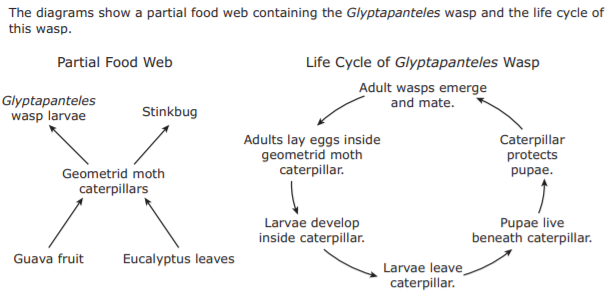
Based on the two diagrams, which list correctly identifies the
relationships Glyptapanteles
wasp larvae have with other
organisms?
F
• Competition: stinkbugs
• Parasitism:
geometrid moths
G
• Competition: geometrid moths
•
Commensalism: stinkbugs
• Mutualism: guava and eucalyptus
trees
H
• Competition: stinkbugs and geometrid moths
•
Commensalism: guava and eucalyptus trees
J
• Parasitism:
geometrid moths
• Commensalism: stinkbugs
• Mutualism: guava
and eucalyptus trees
F
Male guppies found in areas without predators are more colorful than
the ones found in locations with large predator populations. A
population of adult guppies originating from an area with a large
number of predators is transferred to a nearby area with few
predators.
Which of these is most likely to happen over a few
generations?
A The mortality rate of the guppies will
increase.
B Offspring will stop competing for resources.
C
There will be an increase in mutations in the offspring.
D There
will be an increase in the number of colorful guppies
D
Grassland ecosystems in Texas have evolved to depend on periodic
fires to return nutrients to the soil and encourage plant
reproduction. Humans have prevented fires in many of these grassland
areas, resulting in plant and animal communities with little
diversity. Wildlife biologists often recommend purposefully starting
fires called prescribed burns, which are monitored and controlled, in
grassland ecosystems every 3 to 4 years. These biologists observe
greater diversity in plant and animal life in the years following a
prescribed burn.
What natural processes are the biologists
attempting to imitate?
F Biomagnification
G
Succession
H Population bottleneck
J Species extinction
G
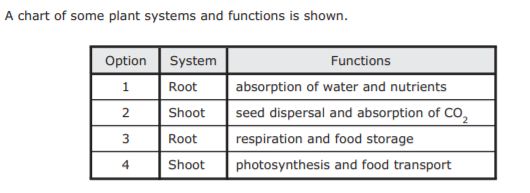
Which system interactions are dependent on the plant’s ability to
respond to the direction of light?
A Option 1
B Option
2
C Option 3
D Option 4
D
Exposure to the building material asbestos has been linked to certain
types of cancers. Asbestos causes mutations in the p53 gene, which
controls tumor suppression. Which statement best explains why people
with cancer due to asbestos exposure do not pass the mutation on to
their offspring?
F The mutation occurred in gametic cells.
G
The mutation occurred in somatic cells.
H The mutation is
recessive.
J The mutation is sex-linked.
G
Which of these components are found in the cells of all living
organisms?
A Estrogen and testosterone
B Hemoglobin and
lymphocytes
C Cytosine and guanine
D Cellulose and chlorophyll
C
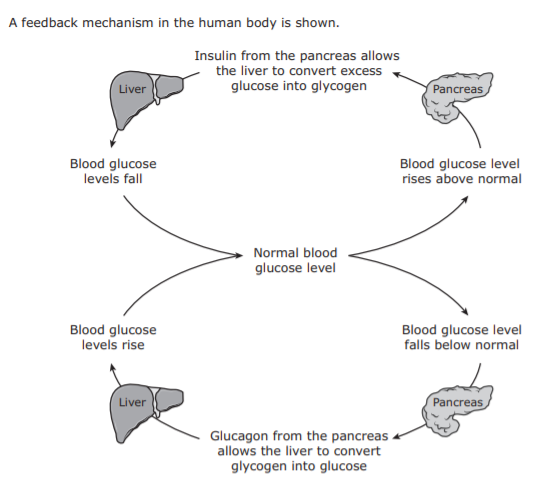
Based on this diagram, which two systems interact to maintain
homeostasis?
F The nervous and reproductive systems work together
to stimulate the production of insulin.
G The circulatory and
endocrine systems work together to keep blood sugar levels
constant.
H The excretory and nervous systems work together to
convert glycogen into glucose.
J The immune and circulatory
systems work together to circulate blood through the pancreas.
G
Which role of protists has the most positive effect on maintaining
the plant population in an ecosystem?
A Protists are a major food
source for animals.
B Protists produce approximately 75 percent
of the oxygen on Earth.
C Protists decompose dead materials,
returning nutrients to the soil.
D Protists found in the gut of
animals assist in digestion.
C
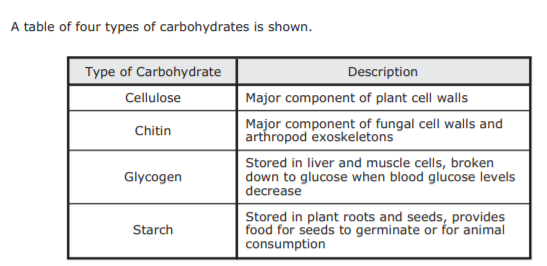
Which list correctly matches the functions to the types of
carbohydrates?
F Energy: glycogen and starch, Structure:
cellulose and chitin
G Energy: cellulose and chitin, Structure:
glycogen and starch
H Energy: chitin and glycogen ,Structure:
cellulose and starch
J Energy: cellulose and starch ,Structure:
chitin and glycogen
F
Gametes produced by an organism contain a combination of genes from
that organism. In every gamete, this combination is —
A the same
because it is created from the same DNA
B the same because
chromosomes are copied prior to meiosis
C different due to DNA
replication prior to mitosis
D different due to independent
assortment during meiosis
D
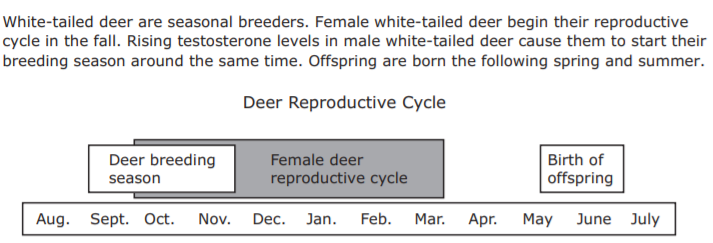
What is the most likely explanation for white-tailed deer having a
seasonal breeding cycle instead of a monthly breeding cycle like many
domesticated animals?
F Male and female deer come into contact
with each other only in the fall.
G Large predators are not found
in deer habitats during the spring and summer months.
H Giving
birth only in the spring and summer ensures that offspring are born
when food is most available.
J Deer give birth in the spring and
summer in order to avoid being pregnant during the hot summer months.
H

Which of these is the correct complementary DNA strand for the
segment shown?
A 5’ AGGTCAGGT 3’
B 5’ ACCUGAGGU 3’
C 5’
TGGACTGGA 3’
D 5’ TCCAGTCCA 3’
D
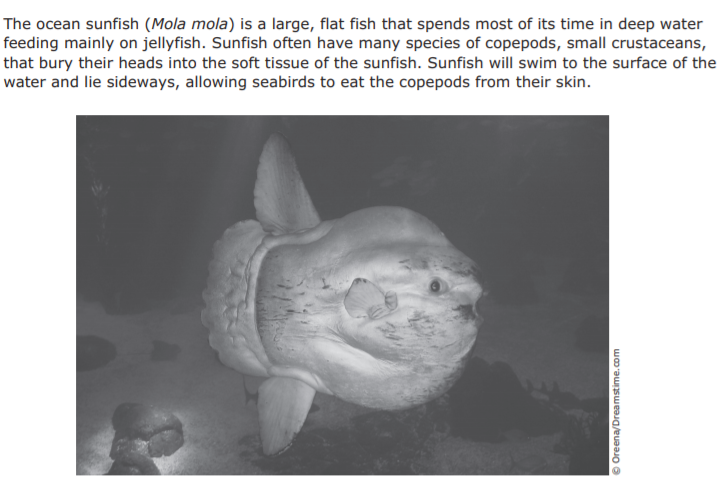
Which list describes the types of relationships the sunfish has with
other marine organisms?
F: Seabirds: mutualism, Jellyfish:
predation, Copepods: parasitism
G: Seabirds: parasitism,
Jellyfish: commensalism, Copepods: predation
H: Seabirds:
predation, Jellyfish: mutualism, Copepods: commensalism
J:
Seabirds: commensalism, Jellyfish: parasitism, Copepods: mutualism
F
Which statement accurately describes the energy needs for
photosynthesis and cellular respiration?
A Solar energy is needed
for cellular respiration but not for photosynthesis.
B Chemical
energy in the form of glucose is needed for both cellular respiration
and photosynthesis.
C Chemical energy in the form of glucose is
needed for photosynthesis, and solar energy is needed for cellular
respiration.
D Solar energy is needed for photosynthesis, and
chemical energy in the form of glucose is needed for cellular respiration
D
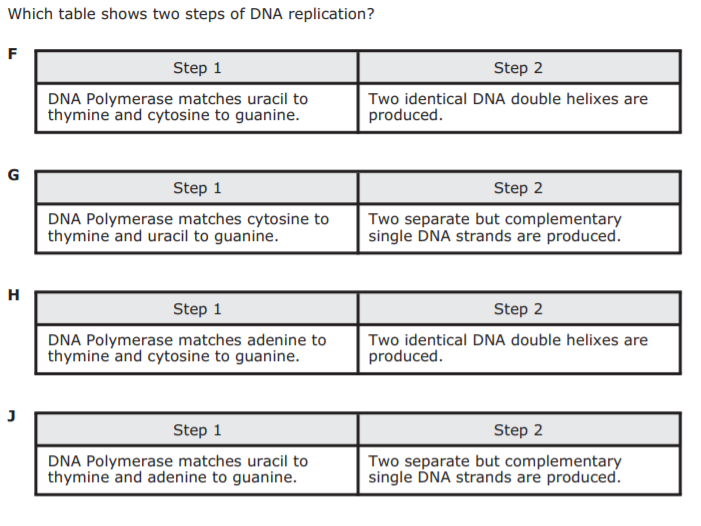
H
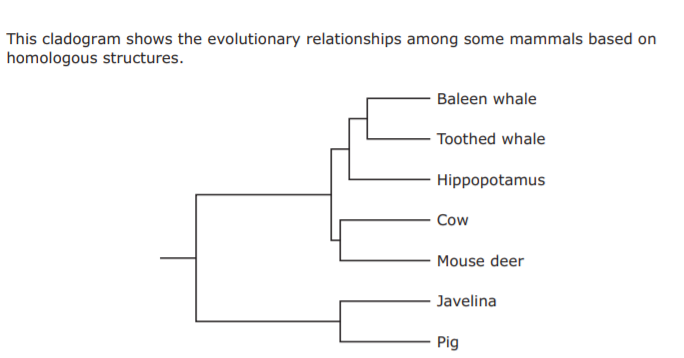
Which statement is supported by this cladogram?
A Hippopotamuses
are more closely related to cows than to javelinas.
B Toothed
whales are more closely related to mouse deer than to
hippopotamuses.
C Javelinas and pigs are more closely related
than baleen whales and toothed whales.
D Cows and mouse deer are
more closely related than javelinas and pigs.
A
Some species of millipedes will roll into a ball when threatened,
while other species of millipedes can secrete noxious chemicals from
their bodies.
These adaptations allow the millipedes to —
F
survive in different temperatures
G avoid different types of
predators
H conserve different amounts of energy
J blend
into different types of environments
G
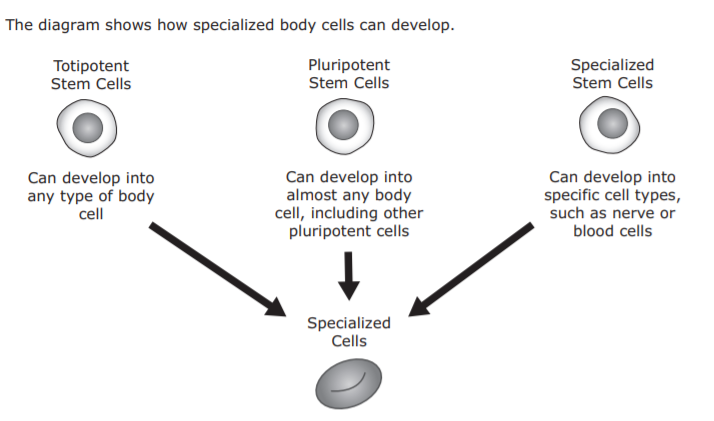
Which of the following best explains why cells that contain the same
genetic material do not develop into the same types of cells?
A
Because internal or external stimuli can trigger the activation of
specific genes in the DNA of cells
B Because random mutations can
occur in the DNA of cells during early embryonic development
C
Because messenger RNA is converted to transfer RNA when cell
differentiation begins
D Because chemical signals that are
released during the cell cycle can result in the linking of similar genes
A
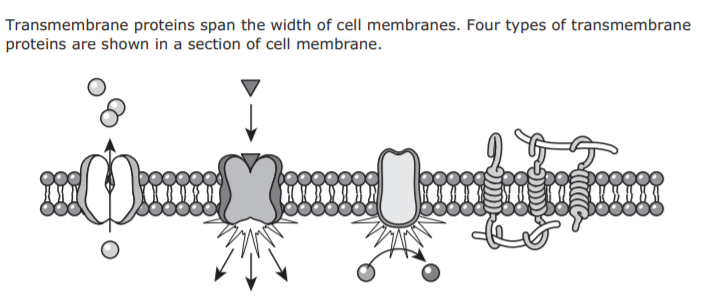
Although these proteins have different specific functions, they all
—
F stop chemical reactions within the cell
G synthesize
molecules that signal other cells
H help the cell interact with
its external environment
J remove large waste particles from the
cytoplasm of the cell
H